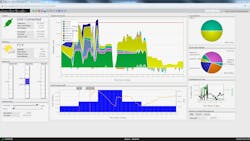Siemens Advanced Microgrid Controller: The Industry’s Latest Red Car
Microgrid controllers are becoming the red car of the microgrid indusry. You buy a red car, and you suddenly see red cars everywhere.
This week’s most eye-catching red car came from Siemens with the announcement of its new advanced microgrid controller software. The controller not only manages resources within the microgrid, but also facilitates microgrid participation in energy markets.
The Siemens announcement marked the third new microgrid controller to come across our desks at MicrogridKnowledge.com over the last week. Why are microgrid controllers — often described as the brains of the microgrid — suddenly getting so much attention?
It says something about the larger growth of the microgrid industry, according to Peter Asmus, a principal research analyst at Navigant Research, who has been tracking the microgrid market.
“The uptick in announcements of new microgrid controller products is a reflection of the fact that microgrids are moving into full-scale commercial deployments,” Asmus said.
Asmus calls the microgrid controller the “magic sauce for microgrids, the black box if you will.”
Advanced controllers don’t just manage the relationship of load, supply and storage within the microgrid. They also manage the relationship of the microgrid to the central grid. This relationship is becoming increasingly important: it provides the central grid with much-needed services and the microgrid with an additional source of revenue.
“Navigant has forecasted that software controls will double in revenues over the next ten years as a proportion of the overall microgrid spend, in large part due to a new focus on provision of ancillary services,” Asmus said. “Rather than microgrids merely providing value internally to a private campus or military base, there is growing regulatory support and interest in microgrids being a good neighbor to the grid, increasing resilience not only through safe islanding, but in providing emergency power, demand response and other services to the host distribution utility.”
Siemens understood the importance of this relationship as it developed its advanced microgrid controller, which it calls Spectrum Power 7 Microgrid Management System.
Ravi Pradhan, vice president, technology strategy at Siemens Smart Grid Division, said that Siemens looked closely at the economics of microgrids, what he calls the “optimization” opportunity.
“Our microgrid manager allows the user or operator to figure out what is the lowest means of producing energy within that microgrid and how best to make use of that energy. It might mean we do some load shifting, etc. to get the maximum benefit. Once we’ve done that, you’ve figured out a means of comparing the microgrid’s economics against the economics of buying from the grid,” he said in a recent interview.
For example, the microgid might use batteries to store solar energy when rates are low and then discharge back to the grid when the power prices rise.
“Our tool essentially provides a good indication of what your current position is such that you can bid in your energy or your load into the broader energy market,“ he said.
Courtesy of Siemens
The Siemens’ controller can look from 15 minutes to seven days into the market, so Siemens envisions it being used in both real-time markets and day-ahead markets.
Increasingly complex controllers, like Siemens’ new product, are needed because microgrids are becoming increasingly complex, said Sally Jacquemin, Siemens microgrid business manager.
“When you add single generation or back-up diesel here or there you may not need advanced control of that generation source. But as you add solar and wind and batteries, you have a more complex generation environment,” she said.
The controller helps guide and manage the energy flow between multiple generation sources and loads. “When you start adding in functionality like islanding or off grid load, where you are disconnected from the broader utility, you need an advanced control system to manage the flow of electricity,” she said.
More details on the new Siemens microgrid controller are here.
About the Author
Elisa Wood
Editor-in-Chief
Elisa Wood is the editor and founder of EnergyChangemakers.com. She is co-founder and former editor of Microgrid Knowledge.
